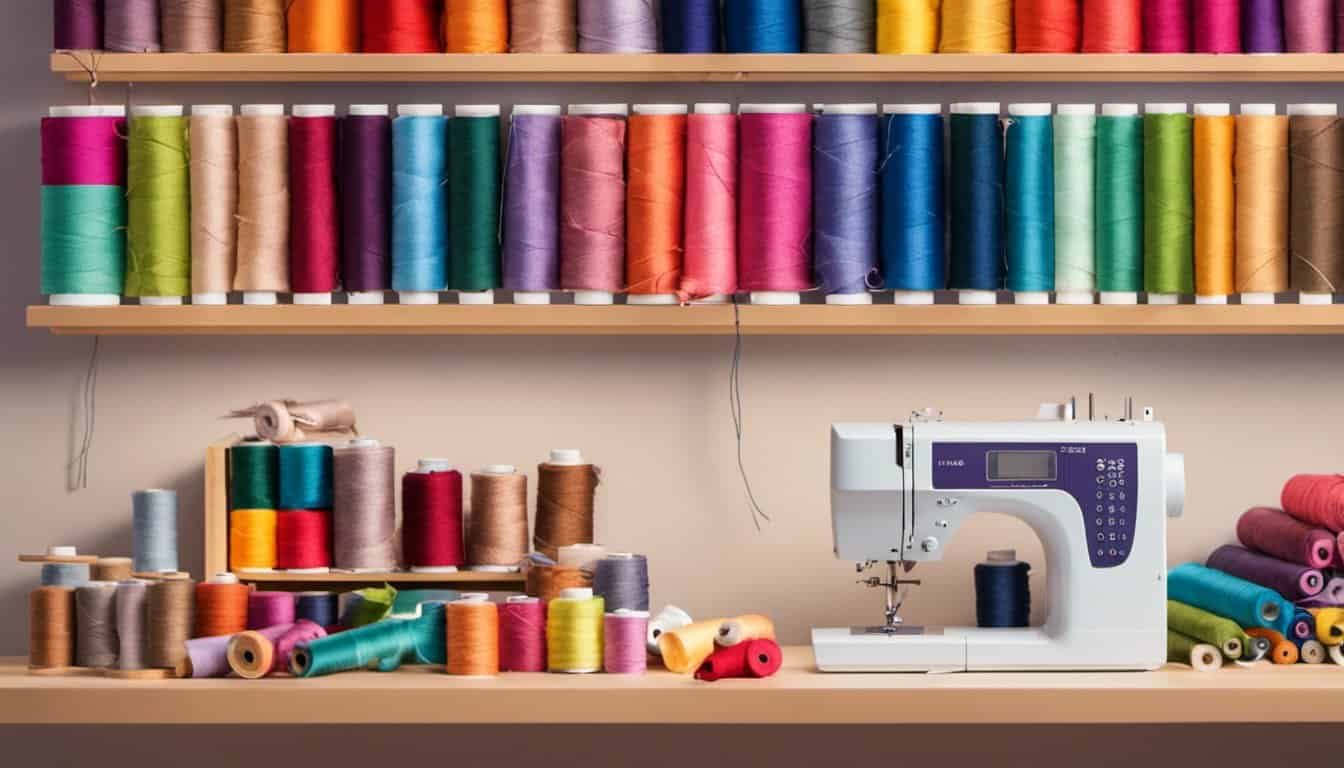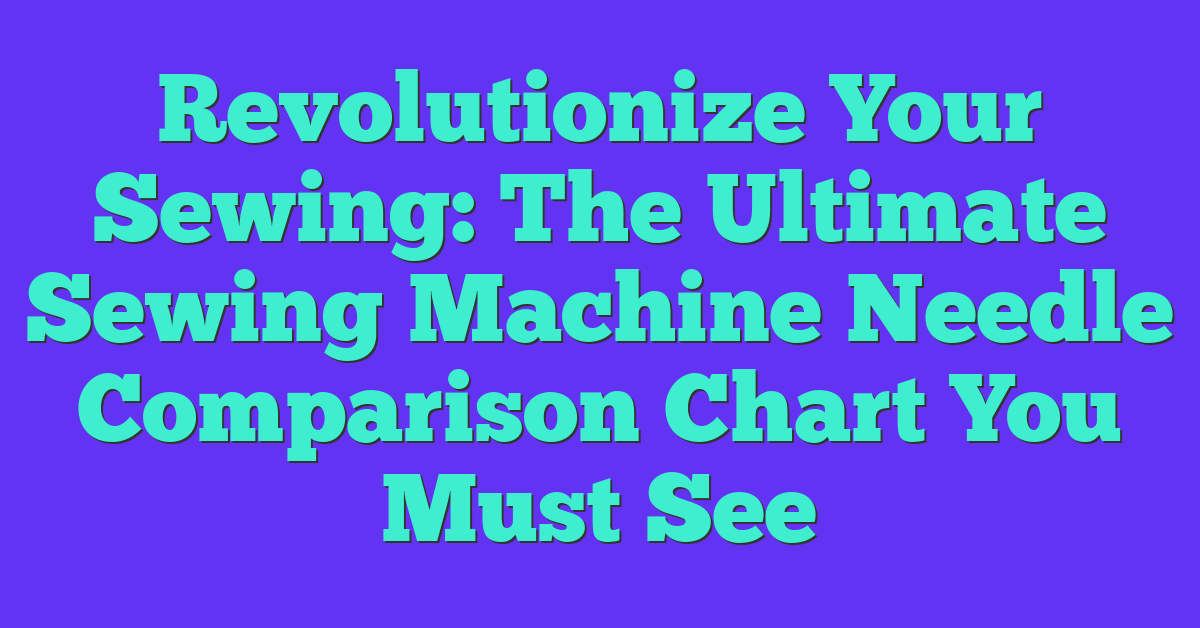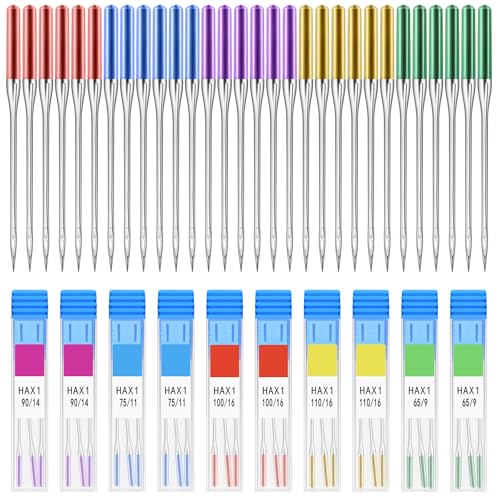Ever tried to sew a delicate silk blouse only to end up with puckered seams? Or maybe your denim project resulted in broken needles? Choosing the right sewing machine needle can make or break your sewing experience. With so many needle types and sizes out there, it’s easy to feel overwhelmed.
Understanding Sewing Machine Needles
Knowing the right sewing machine needle can significantly boost your sewing experience. The type and size of the needle affect the quality of your stitches and the ease of your work.
Types of Sewing Machine Needles
Sewing machine needles come in various types for different purposes:
- Universal Needles: Suitable for most woven and knit fabrics, these needles are the most versatile.
- Ballpoint Needles: Ideal for knit fabrics, ballpoint needles slide between fibers rather than piercing them.
- Sharps (Microtex) Needles: Perfect for fine fabrics like silk or microfiber, these needles have a slim, precise point.
- Denim Needles: Built to handle heavy fabrics like denim, these needles have a robust shank and a very sharp point.
- Stretch Needles: Best for highly elastic fabrics such as spandex, stretch needles have a unique scarf to prevent skipped stitches.
- Quilting Needles: Designed for machine quilting, these needles have a tapered point for easier fabric piercing without damage.
- Embroidery Needles: Specifically for embroidery, these needles have a special eye and groove to accommodate embroidery thread.
Selecting the Right Needle for Fabric
Choosing the appropriate needle for your fabric enhances stitch quality and reduces problems:
- Lightweight Fabrics (e.g., chiffon, organza): Use size 60/8 or 70/10 Sharps needles. They prevent puckering and thread breakage.
- Medium-weight Fabrics (e.g., cotton, linen): Opt for size 80/12 or 90/14 Universal needles. They handle the variety of fibers in these fabrics.
- Heavy Fabrics (e.g., canvas, denim): Use size 100/16 or 110/18 Denim needles. They can penetrate thick layers without bending.
- Stretch Fabrics (e.g., jersey, lycra): Select size 75/11 or 90/14 Stretch needles. These needles help prevent skipped stitches.
- Delicate Fabrics (e.g., satin, taffeta): Choose size 70/10 or 80/12 Microtex needles. They minimize fabric damage and ensure smooth sewing.
- Quilt Layers: Use size 75/11 or 90/14 Quilting needles. They maneuver through multiple fabric layers and batting efficiently.
Understanding needle types and sizes ensures you achieve the best results in your sewing projects.
Features of Different Sewing Machine Needles
Selecting the right sewing machine needle enhances your sewing experience significantly. Various needles cater to different fabrics and sewing techniques.
Needle Sizes and Their Uses
Needle sizes impact stitch quality and fabric handling. Sizes range from 60/8 to 120/19. Smaller sizes (60/8, 70/10) are ideal for lightweight fabrics like silk and organza. Medium sizes (80/12, 90/14) suit general-purpose sewing on cotton, polyester, and wool. Larger sizes (100/16, 110/18) handle heavy fabrics like denim and canvas. Always match needle size to fabric weight for better results.
Needle Point Types and Their Applications
Various needle points cater to specific materials. Universal needles have a slightly-rounded point for woven and knit fabrics. Ballpoint needles have a rounded tip, ideal for knits and stretch fabrics, preventing fabric damage. Sharp needles come with a fine point for tightly woven fabrics like silk and microfiber. Denim needles have a strong, sharp point for piercing heavy woven fabrics. Stretch needles feature a medium ballpoint and specialized eye for elastic materials. Quilting needles have a tapered point, reducing fabric damage while piecing. Embroidery needles come with a larger eye for specialized threads, enhancing embroidery stitches. Select the right point type based on your fabric to avoid issues like puckering or skipped stitches.
Review of Popular Sewing Machine Needles
Selecting the right sewing machine needle can elevate your sewing projects. Examine some of the top brands and customer reviews to make an informed choice.
Top Brands and Their Needle Offerings
Schmetz
Schmetz is a trusted name known for its wide variety of needles. They provide Universal, Ballpoint, and Denim needles among others. Each type suits specific fabrics like cotton, knits, or denim, ensuring versatility for any project.
Singer
Singer’s sewing machine needles are popular due to their durability and precision. Their offerings include needles for various applications: Universal for general sewing, Sharps for lightweight fabrics, and Heavy-Duty for thick materials.
Organ
Organ needles boast high-quality manufacturing. They offer a range including Embroidery needles to prevent thread breakage and Stretch needles designed to tackle elastic fabrics without causing skipped stitches.
Janome
Janome provides needles tailored for their machines. They offer specialized needles like Blue Tip for embroidery and Red Tip for heavy fabrics, ensuring optimal performance for different sewing tasks.
Customer Reviews and Feedback
Schmetz Reviews
Many customers praise Schmetz for its consistent quality. Users appreciate the smooth sewing experience and fewer thread breakages. One common highlight is the comprehensive variety catering to different fabric needs.

Singer Reviews
Singer needles receive positive feedback for sturdiness and sharp points. Customers report fewer needle breaks and cleaner stitches, particularly with the Heavy-Duty needles. This brand often garners loyalty due to compatibility with various sewing machines.
Organ Reviews
Organ needles are commended for their affordability without compromising quality. Customers often mention the effectiveness of Embroidery and Stretch needles in handling delicate and stretchy fabrics, respectively.
Janome Reviews
Janome gets high marks for compatibility with its machines and specialized needles. Customers appreciate the Blue Tip and Red Tip needles for delivering precise results. Users note reduced skipped stitches and seamless sewing on thick and lightweight fabrics alike.
Using the Sewing Machine Needle Comparison Chart
A comprehensive needle comparison chart helps simplify the process of choosing the right needle. You’ll find valuable information to optimize your sewing projects.
How to Read the Chart
Understand various columns in the comparison chart for effective usage. Typically, these columns, including needle type, size, compatibility, and recommended fabrics, will guide you in making informed choices.
- Needle Type: Check this column for specific needle designs like Universal, Ballpoint, and Denim. Each type has unique characteristics tailored to particular fabrics and sewing techniques.
- Needle Size: Look at the sizes, generally ranging from 60/8 to 110/18. Smaller sizes suit lightweight fabrics, while larger sizes handle heavier materials.
- Compatibility: This section lists machine brands compatible with each needle type. Ensuring compatibility prevents issues like skipped stitches.
- Recommended Fabrics: Reference this to match needles with appropriate fabrics. For example, Ballpoint needles are ideal for knits, while Sharps excel with woven fabrics.
Comparing Needle Durability and Price
« Can You Floss with Sewing Thread? Discover Surprising Truths and Dangers
Is Sewing a Good Business? Discover the Surprising Profit Potential in Custom Apparel »
Examine the chart for insights on needle longevity and cost-efficiency. Durable needles reduce frequent replacements and enhance sewing quality.
- Durability: Compare needles from brands like Schmetz and Singer, known for superior strength and lifespan. Durability ensures consistent performance without frequent breakage.
- Price: Evaluate the price point among various brands and needle types. Affordable options without compromising quality provide value, especially for high-volume sewing tasks. Brands like Organ offer budget-friendly, durable needles.
Using the sewing machine needle comparison chart effectively equips you with knowledge to enhance your sewing projects.
Conclusion
Choosing the right sewing machine needle can make a world of difference in your sewing projects. With so many options out there, having a comparison chart simplifies the process and ensures you pick the perfect needle for your fabric. By understanding the details in the chart, you can easily compare types, sizes, and brands like Schmetz, Singer, and Organ.
Remember, investing in durable and cost-efficient needles not only enhances your sewing quality but also saves you money in the long run. So next time you’re at a crossroads about which needle to choose, refer to the comparison chart and sew with confidence!


















